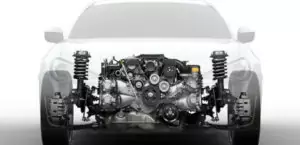The Renault E7J 1.4-liter 8-valve engine first appeared in 1991. Structurally, it is based on the popular Cleon-Fonte engine, but with an overhead camshaft, that is, in the cylinder head. Installed on Renault 19, Megane, Kangoo, Clio, and Dacia Solenza, SupeRNova. The version of the engine with a carburetor power system is called the E6J.
The E-series also includes: E7F.
At the end of the 80s, the concern’s engineers finally realized that nothing more could be squeezed out of the OHV-type C-series engines. It’s time to switch to the OHC scheme, that is, with a camshaft in the cylinder head and a toothed belt to transmit torque from the crankshaft.
Thus, the E-series appeared, which laid the foundation for a huge family of low-volume power units with indices K and D, which are still actively installed on a number of budget models of the Franco-Japanese alliance. Of course, over the years, mono-injection has given way to distributed injection, but the design basis has been without significant changes for 30 years.
In 1997, a new 1.4-liter K7J engine appeared, which finally abandoned wet liners in favor of a cast block. However, the old motor remained in the conveyor for almost 10 more years, it was put on the Romanian Dacia cars.
The engine was installed on:
- Dacia Solenza 1 (B41) in 2003 – 2005;
- Dacia SupeRNova 1 (B41) in 2000 – 2003;
- Renault 19 (X53) in 1993 – 1995;
- Renault Clio 1 (X57) in 1991 – 1998; Clio 2 (X65) in 1998 – 2001;
- Renault Express 1 (X40) in 1991 – 1998;
- Renault Kangoo 1 (KC) in 1997 – 2001;
- Renault Megane 1 (X64) in 1995 – 2000;
- Renault Scenic 1 (J64) in 1996 – 2003.
Specifications
| Production years | 1991-2005 |
| Displacement, cc | 1390 |
| Fuel system | mono-injection |
| Power output, hp | 70 – 80 |
| Torque output, Nm | 105 – 114 |
| Cylinder block | R4 |
| Block head | 8v |
| Cylinder bore, mm | 75.8 |
| Piston stroke, mm | 77 |
| Compression ratio | 9.2 – 9.5 |
| Timing drive | belt |
| Turbocharging | no |
| Fuel type | petrol |
| Euro standards | EURO 1 |
| Engine lifespan, km | ~200 000 |
| Weight, kg | 122 |
Disadvantages of the Renault E7J engine
- The cause of the unstable operation of the power unit is usually: air leakage, a burned-out lambda probe, a faulty fuel pump, or failure of the single injection nozzle.
- Trouble of the motor is often caused by a cracked cover of the distributor. It is also worth checking the candles and high-voltage wires.
- The electrical part of the engine is very capricious, especially in wet weather. Many sensors can fail, but let’s single out the two most unreliable: the temperature of the coolant and the incoming air.






